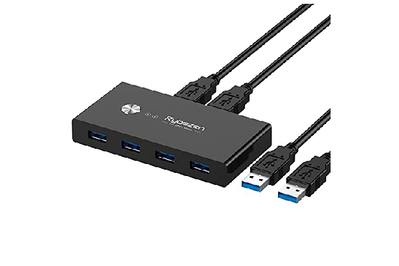[ad_1]
I’m neurotic about my desk space. I can’t work unless my space is completely clear and organized, and I’ve spent an unconscionable amount of time below my desk like a mechanic under a hood, meticulously hiding loose cables. But even after all that work, I was often frustrated by the tedious dance of plugging and unplugging all of my peripherals every time I wanted to switch between my work and personal computers. So I started looking for ways to simplify the swap between two computers sharing the same monitor, and thankfully, I found KVM switches.

A KVM (keyboard, video, and mouse) switch allows you to plug multiple computers and peripherals into one hub and, with the press of a button, switch back and forth between the computers without having to move or rewire anything. Some monitors and keyboards have built-in KVM switches, but if yours don’t, you can find a ton of options for hubs that range in price and size. I drifted toward the cheaper end of the spectrum because I first wanted to see if a KVM switch would solve my problem before springing for a more expensive version with more features. It’s been over a year since I purchased the $20 Rybozen 4-Port USB 3.0 Switch, and that model has worked perfectly—I haven’t needed to upgrade.
Before buying a KVM switch, I took stock of which peripherals I used on a regular basis: a USB microphone, an external webcam, and a wireless mouse and keyboard that each connect through a USB-A dongle. So I looked for a KVM switch that had at least four USB-A ports.
Ideally, I wanted a switch that would also swap my monitor input automatically. But because I connect my computers to my monitor using both DisplayPort and HDMI—a feature available only in more expensive KVM switches—I decided I could live with changing the input on my monitor manually. For me, this small annoyance was worth the difference between a $20 KVM switch and a $200 model.
In my initial research, I was concerned about latency affecting my peripherals, and I got especially into the weeds when I considered the switches that offered video output. But I learned that I, like most people, don’t need to worry about that. I found that unless you play games competitively online, or if you have a nice PC gaming rig and you want specific resolution and refresh-rate support, you aren’t likely to notice any problems with lag—even with a cheaper KVM switch.
Setting up the KVM switch was a breeze. The Rybozen switch came with two USB cables out of the box, which I used to connect each of my computers to the back of the hub. Through the four USB ports in the front, I connected my peripherals. For extra peace of mind, I also attached the switch to the bottom of my desk using double-sided Velcro to keep it, and any wires running to it, out of sight.
And that was it—now, with both computers turned on, a simple press of the button on the KVM switch seamlessly pairs my peripherals with one or the other in less than a second. The only thing I have to do to transition between my work and personal computers is manually select the input on my monitor and press a button on the KVM switch. With a desk free of clutter and no devices to fuss with, I can finally work without distraction—well, without that distraction, anyway.
This article was edited by Kimber Streams and Annemarie Conte.
[ad_2]


